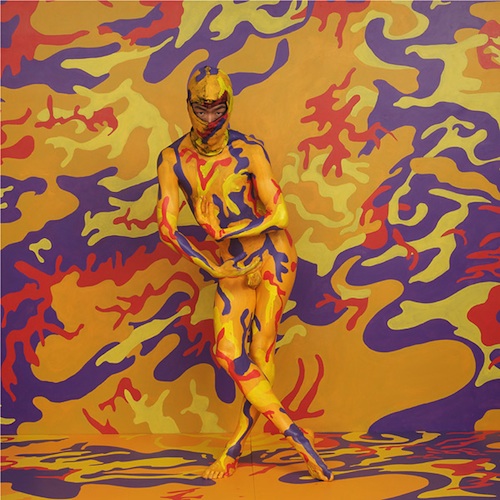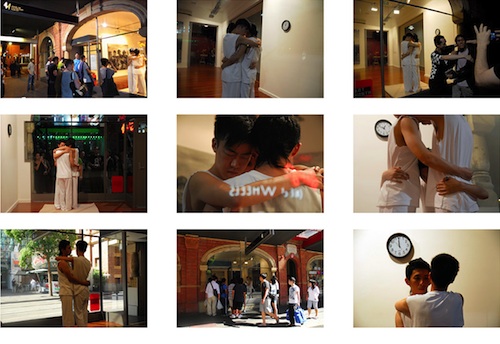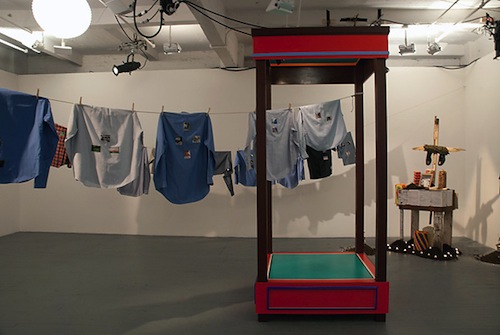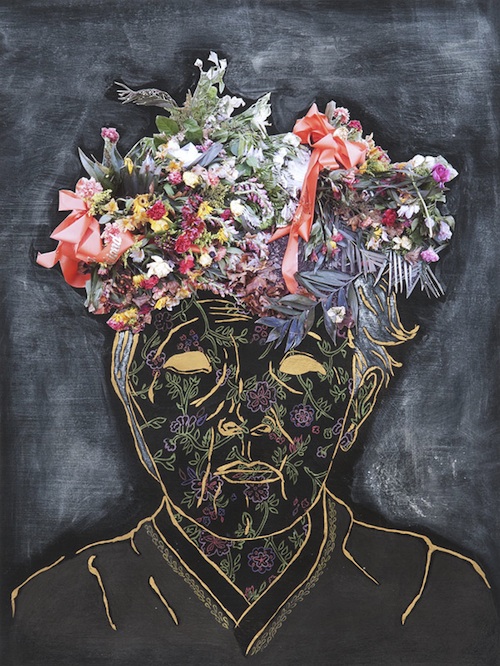
Young Sun Han. “Dance of the Cockatrice #1,” 2010. Digital C-type print on Fuji Crystal Archive pearl paper, 16 x 16 in. Edition 1/5. Courtesy the artist.
To be on a reality television show, contestants voluntarily leave their familiar surroundings, home life, and regular routines to temporarily thrust themselves into a world dictated by short attention spans and video editors with their own agendas. While on the show, contestants usually cannot watch news, listen to the radio, or peruse the Internet. They can’t even use their mobile phones. It’s a “residency experience” in an entirely different sense of the phrase.
Nearly a year ago, Young Sun Han’s lust for adventure led him to participate in Season 2 of “Work of Art: The Next Great Artist,” the now-canceled reality TV show on BRAVO in which artists competed for the grand prize of $100,000 and a solo show at the Brooklyn Museum. Unlike a typical residency—where artists develop a single piece or body of work in a low-pressure environment and might casually form friendships—artists here quickly formed tight bonds and under the strain of constant competition and an omnipotent, mediated audience of judges and other art worlders.
Han’s experience on “Work of Art” not only pushed him to create work with unfamiliar materials, but also completely shifted his practice away from endurance-based performance to sculpture and works on paper.
“At the time I auditioned for ‘Work of Art,’ I was working almost solely in performance,” says Han. “I had abandoned an object-based practice because I was really interested in using the body as a sculptural element and as a live circuit for interactions that happen with an audience, so it somehow tied into this reality TV experience—I wasn’t only the creator of work but I became the thing being consumed on television.”

Young Sun Han. “Sliding Mirror: 24 Hour Embrace,” 2010. Performance photo documentation. Courtesy the artist.
Before applying for the show, Han had done performances such as Sliding Mirror: 24 Hour Embrace (2010), a 24-hour piece that was first performed in New Zealand, where he resided for a few years and has permanent residency. (He’s also a United States citizen). Through online listing services, he found strangers matching his own physical characteristics, invited them to the gallery, and asked each person to embrace him for 24 hours straight once the clock struck midnight. It resulted in an intimate relationship between strangers that was not sexual in nature, yet created a temporal intimacy that, much like anonymous hookups à la Grinder or Craigslist, would never happen again.
For another piece, Dance of the Cockatrice (2010), the artist painted his body a yellow, purple, red, and orange camouflage, and performed against a background and floor bearing the same pattern. Throughout the performance, he peeled away his “second skin” to reveal the first layer of his own, suggesting how individuals camouflage themselves in an effort to blend into new environments.
Given the breadth of his performance work, and background in theatre, BRAVO’s interviewers were skeptical of Han’s ability to be his “authentic” self on the show.
“Do I present a constructed version of Young or the real Young?,” the artist wondered. “After the interview I decided that I had to play myself instead of create an alternative character to go with my reality TV show appearance.”
Rather than continue orienting his practice around the body and performance, which would have been difficult to sustain under such fast-paced and labor-intensive conditions, Han brushed up on his preexisting two- and three-dimensional art making skills.
“My approach was to treat this as a residency in New York that was fully paid for, to experiment as much as possible, and not to be afraid of new materials and trying something completely out of the regular studio practice,” says Han.
Yet an artist residency typically offers ample time to reflect on the shifts and swings of one’s practice and the results of experimentation.
Han explains, “Whereas in a traditional residency you work toward a final product and debut that publicly, on the show you debut something every two or three days and then you are back in the studio making new work.”
After the first “Work of Art” challenge–for which Han transformed a kitsch painting of dogs playing mahjong into a live performance that involved dolling out fortunes to strangers–he abandoned performance art entirely. He knew he had to do so if he wanted to make it to the final round.

Young Sun Han. “Bool-sa-jo,” 2011. Mixed media. Dimensions variable. Installation view at Phillips de Pury, New York. Courtesy the artist.
“I feel like it’s a great creative exercise to make something new, and then have a time constraint in which to finish it,” says Han. “When you are in your studio and if you don’t have deadlines, a project can go on six months, or even a year before you finish it. For me it felt liberating, working on so many mediums in a short amount of time.”
Han was taken on a “side quest,” as he calls it. Nearly one year later, he’s still making drawing and objects for the most part. He also continues to wrap his head around the whole reality-TV-as-residency experience.
“Work of Art” came at a difficult emotional time for Han. Just before filming began, he lost his father to cancer. His final entry for the show was a site-specific piece entitled Bool-sa-jo (2011), a memorial type of installation filled with shirts that belonged to his late father, together with the contents of his father’s pockets at the time of his death; photographs of his father in a hospital bed near the end of his life; family memorial shrines; and video-looped portraits of his closest living family members—his mother and his boyfriend Mark.

Young Sun Han. “A shrine for my father,” detail of “Bool-sa-jo,” 2011. Mixed media. Courtesy the artist.
“More than the objects and images on display though, I thought the idea of exhibiting a form of personal commemoration and public mourning would be an interesting way to address the issue of making art for reality TV,” says Han. “The work was also made for my family, especially my mother and late grandmother; it’s our audiovisual family album, a time capsule of this strange adventure in New York.”
Han walked away from the show with the second place prize and a new approach to his work.* In his final recap for Vulture, art critic and “Work of Art” judge Jerry Saltz wrote: “I fancy that Young’s losing a TV game show about art might make his eventual art career easier (though the $100,000 might’ve helped, too). He should move to New York, find a dive in Bushwick, have his New York nervous breakdown and join a promising next wave of talented people.”
Han recently relocated from Chicago to Brooklyn, where he is working on drawings and paintings that relate to his family’s history, but taking a nuanced, more distanced approach.

Young Sun Han. “Matriarch,” 2012. Acrylic, ink, graphite, photo cutout, gold leaf, 16.5 x 12.5 in. Courtesy of the artist.
“[These] pieces are more about the context of my family’s history and being war refugees, and working through historical photos of where they were coming from, and then creating my own narratives around that,” says Han. “They are these more fantasy-based images, or explorations of their life and the context of being in North Korea and escaping the war. Dissolving Ritual and Matriarch combine images of floral mounds where my family are currently interred with re-imagined drawings or sketches based on the older photographs.”
As he settles into his new apartment, Han will reconnect with many of the artists who became good friends while on the show.
“It really did feel like a residency experience in that way,” says Han. “You’re living and breathing and farting with all these other people, so you really do get to know them intimately.”
Young Sun Han’s first solo exhibition opens May 28 at Sanderson Contemporary Art in Auckland, New Zealand.
*Peregrine Honig, the first artist profiled for this series, was runner-up on Season 1 of Bravo’s “Work of Art.” Click here to read about her experience on the show.
Alicia Eler is Blogger-in-Residence through February 28.




Pingback: Unicorns, Ghosts, and a North Korean Past | Nick Socrates Contemporary Art